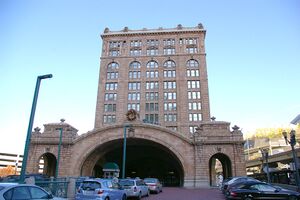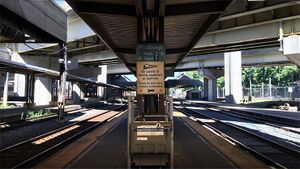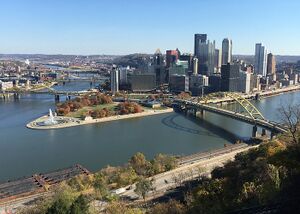
Pittsburgh
| Pittsburgh | |||||
|---|---|---|---|---|---|
| Japanese Name | ピッツバーグ | ||||
| Weapon | |||||
| Race | Human | ||||
| Nationality | |||||
| Birthday | November 25 | ||||
| Constellation | Sagittarius | ||||
| Talents | Weapons maintenance, Remodeling | ||||
| Likes | Ironware, Potatoes on sandwiches | ||||
| Dislikes | Whiny people, Pessimists | ||||
| Strengths | Fighting fair and square | ||||
| Weaknesses | Gets too emotionally involved with weapons and machines | ||||
| Hobbies | Developing weapons | ||||
I'm Pittsburgh, a knight of the Order of St. Iris. I was in charge of logistics before I joined the SSS, so I'm glad to be on the front lines like this. Relax, I'm no novice in combat. I'm training daily so that I can join the Out-Siders someday.
Layers
| Icon | Title | Release Date | Where to Obtain |
|---|---|---|---|
| [Weapons Enthusiast Mechanic] Pittsburgh | 2022 February 24 | [Altar of Judgement - Todoroki Insect King] Event Reward | |
| [Love of Weaponry] Pittsburgh | 2022 February 28 | [Fortune Teller of the Sparkling Lake] Pick Up Gacha, Premium Gacha | |
| [Maiden of Steel] Pittsburgh | 2022 February 24 | [Undercover Mission and the Steel Mechanic] Limited Gacha |
Obtained Skills
Trivia
- Pittsburgh's birthday is shared with Andrew Carnegie in 1835. Nicknamed "Man of Steel", Andrew Carnegie led the expansion of the American steel industry in the late 19th century, found the Pittsburgh's Carnegie Steel Company (the basis of the U.S. Steel Corporation), and became one of the richest Americans in history. By 1911, Pittsburgh was producing half of America's steel.
- Pittsburgh love for ironware reflects Pittsburgh city's extensive history of iron and steel production, nicknamed "The City of Steel". In World War II, it was the center of the "Arsenal of Democracy", producing munitions for the Allied war effort as prosperity returned.
- Pittsburgh's liking for "potatoes on sandwiches" references the Pittsburger - Primanti Brothers' sandwiches of grilled meat, melted cheese, coleslaw, tomato slices, and French fries between two thick slices of Italian bread. During the 2007 James Beard Foundation Awards, Primanti's was named as one of "America's Classic" restaurants.
Counterpart
Union Station (or Pennsylvania Station, commonly called Penn Station) is a historic train station in Downtown Pittsburgh, Pennsylvania, United States. It was one of several passenger rail stations that served Pittsburgh during the 20th century (other stations included the Pittsburgh & Lake Erie Railroad Station, the Baltimore and Ohio Station and Wabash Pittsburgh Terminal), and it is the only surviving station in active use.
The station building was designed by Chicago architect Daniel Burnham and built between 1898–1904. The materials were a grayish-brown terra cotta that looked like brownstone, and brick. Though Burnham is regarded more as a planner and organizer rather than a designer of details, which were left to draftsmen like Peter Joseph Weber, the most extraordinary feature of the monumental train station is his: the rotunda with corner pavilions. At street level, the rotunda sheltered turning spaces for carriages beneath wide, low vaulted spaces that owed little to any historicist style. Above, the rotunda sheltered passengers in a spectacular waiting room. Burnham's firm completed more than a dozen projects in Pittsburgh, some on quite prominent sites. The rotunda is listed on the National Register of Historic Places. Service began at the station on October 12, 1901.
By the late 1970s the Penn Central Corporation was accepting bids for the complex and it was purchased by the US General Services Administration. There were proposals in 1978 to make the structure into a federal office building, a new city hall and a senior citizens apartment building. Amtrak proposed that the whole structure remain a train station and rail offices. A $20 million restoration of Union Station began in 1986 to convert the office tower into apartments. It is now called The Pennsylvanian and opened to residents on May 23, 1988. The concourse, which is no longer open to the public, was transformed into a lobby for commercial spaces on the ground floor and the paint cleaned off the great central skylight. The rotunda, which once offered shelter for carriages to turn around, is now closed to vehicular traffic; modern cars and trucks are too heavy for the brick road surface and risk caving in the roof to the parking garage below it.
Union Station continues to serve as an active railway station, but through an annex on the Liberty Avenue side of the building. It is the western terminus of Amtrak's Pennsylvanian route and is along the Capitol Limited route. Until 2005, Pittsburgh was also serviced by the Three Rivers (a replacement service for the legendary Broadway Limited), an extended version of the Pennsylvanian that terminated in Chicago. Its cancellation marked the first time in Pittsburgh's railway history that the city was served by just two daily passenger trains (the Pennsylvanian and Capitol Limited). Wikipedia
Pittsburgh is a city in the Commonwealth of Pennsylvania and the county seat of Allegheny County. It is the second-most populous city in Pennsylvania, behind Philadelphia, and 68th-largest city proper in the U.S. with a population of 302,971 as of the 2020 census. Pittsburgh is known both as "the Steel City" for its more than 300 steel-related businesses and as the "City of Bridges" for its 446 bridges. The city features 30 skyscrapers, two inclined railways, a pre-revolutionary fortification and the Point State Park at the confluence of the rivers.
The American Civil War boosted the city's economy with increased iron and armament demand by the Union. Andrew Carnegie began steel production in 1875 at the Edgar Thomson Steel Works in North Braddock, Pennsylvania, which evolved into the Carnegie Steel Company. He adopted the Bessemer process, which allowed the high carbon content of pig iron to be burnt away in a controlled and rapid way during steel production. Manufacturing was key to growth of Pittsburgh and the surrounding region. Steel prices dropped as a result, and Bessemer steel was rapidly adopted for rails; however, it was not suitable for buildings and bridges. Railroad lines were built into the city along both rivers, increasing transportation access to important markets. Carnegie made his fortune in the steel industry, controlling the most extensive integrated iron and steel operations ever owned by an individual in the United States.
Carnegie Museums of Pittsburgh are four museums that are operated by the Carnegie Institute headquartered in the Carnegie Institute complex in the Oakland neighborhood of Pittsburgh, Pennsylvania. The Carnegie Institute complex, which includes the original museum, recital hall, and library, was added to the National Register of Historic Places on March 30, 1979.
Map
Gallery
- Pages using Tabber parser tag
- Pages using DynamicPageList3 parser tag
- Weapon Gauntlet
- Human
- St. Iris
- Sagittarius
- Element Blow
- Element Water
- Element Fire
- Element Light
- Train Knights
- United States











